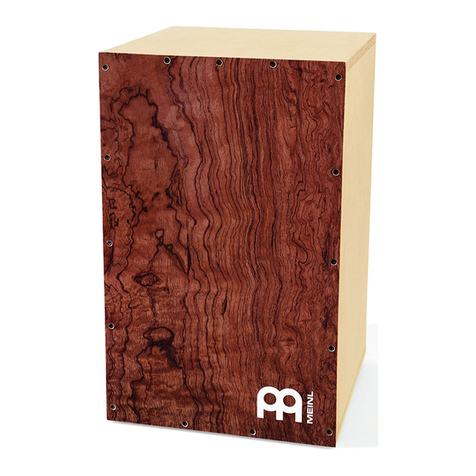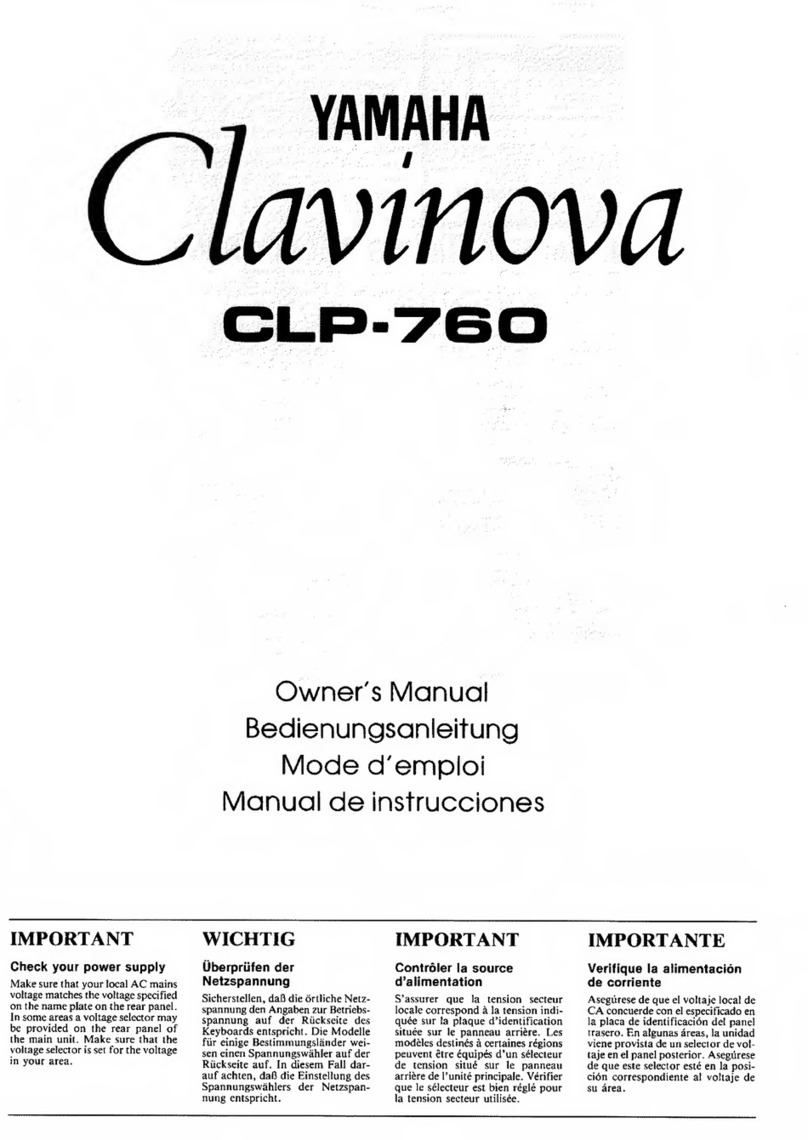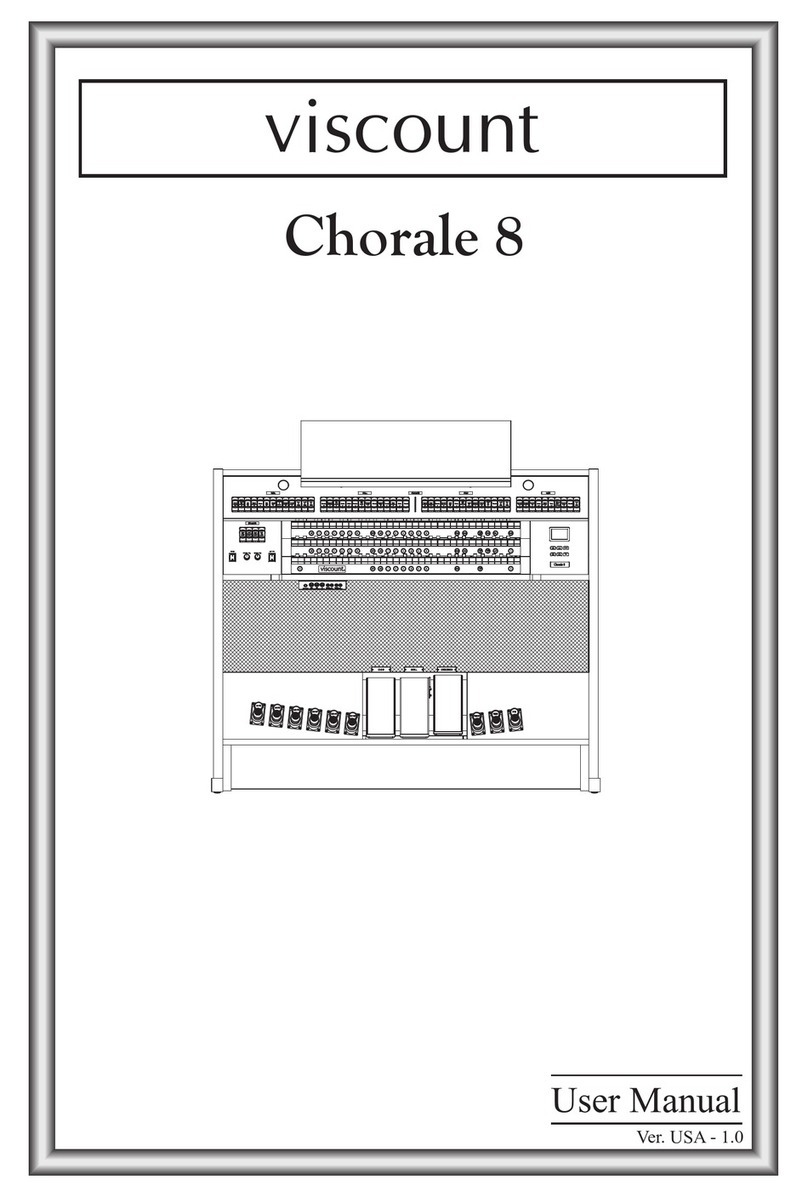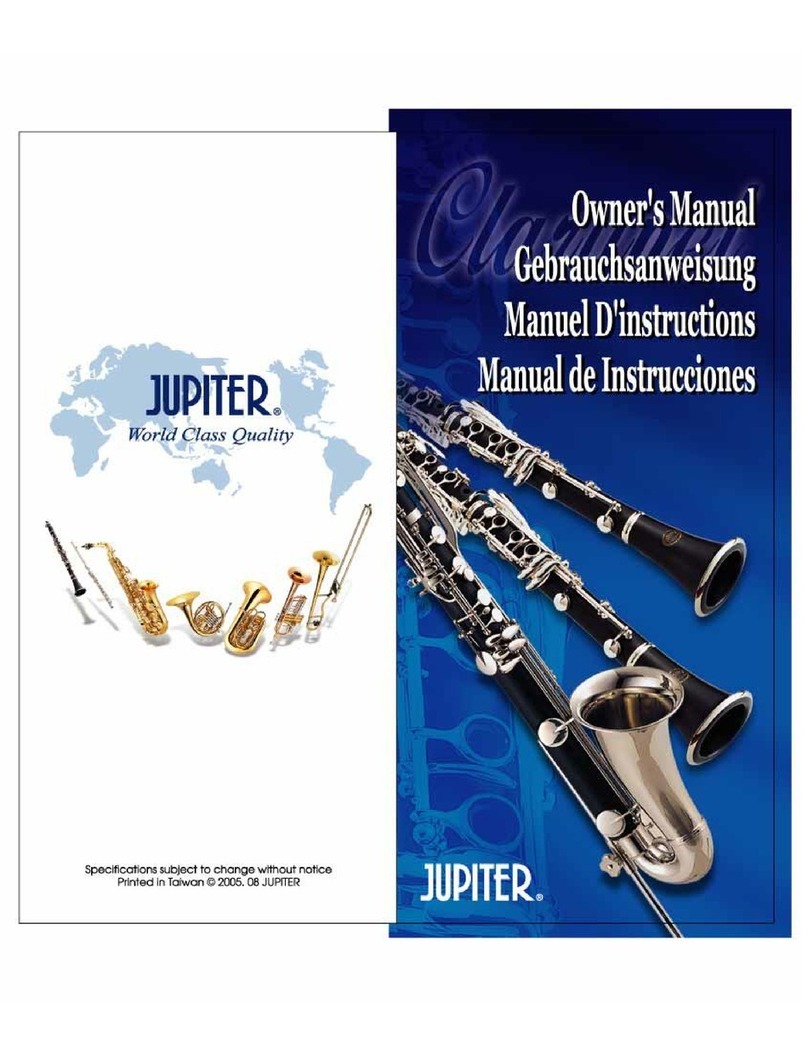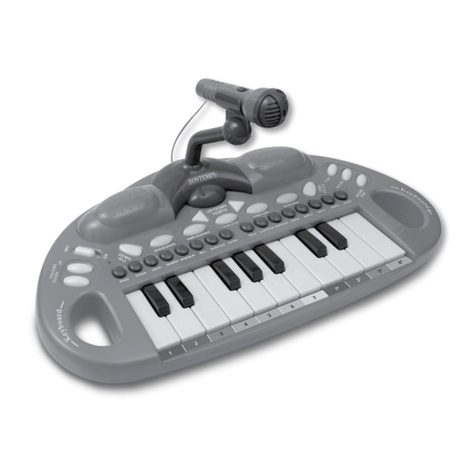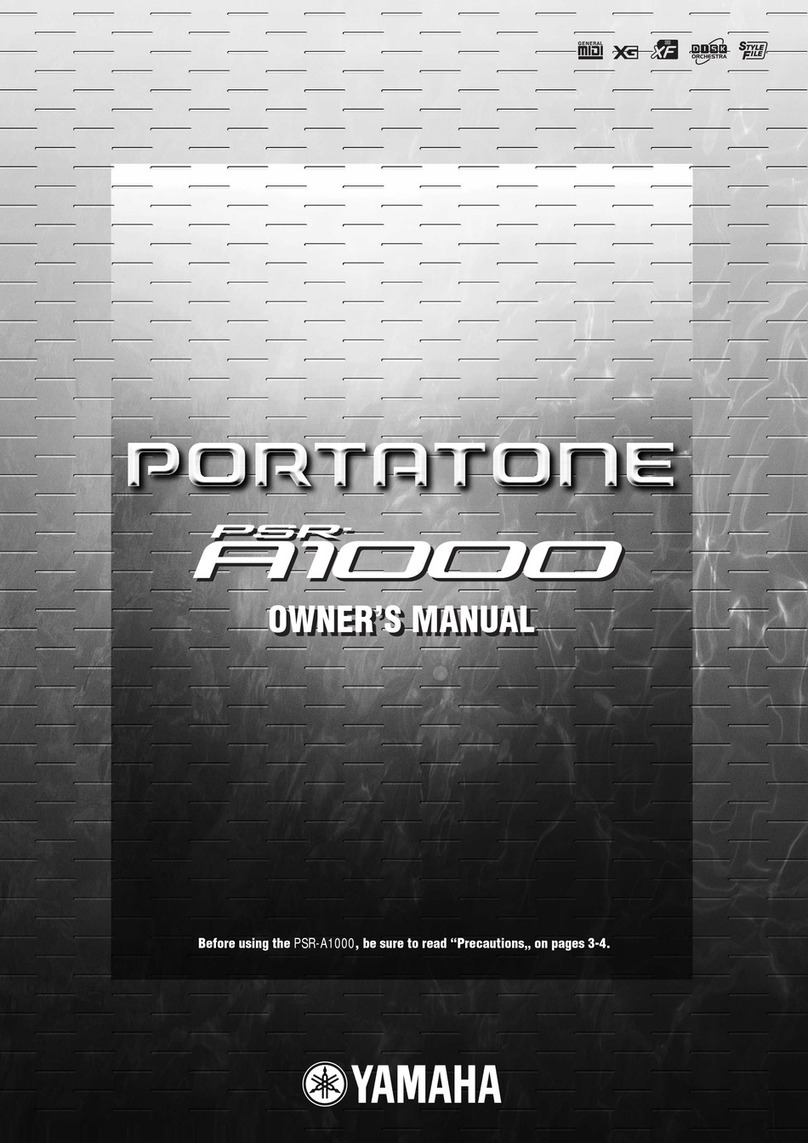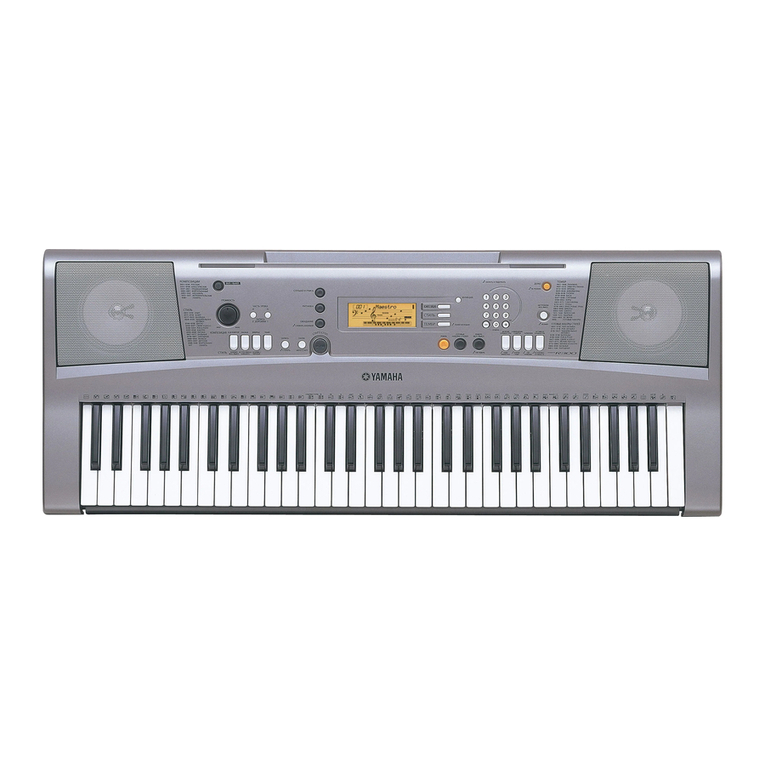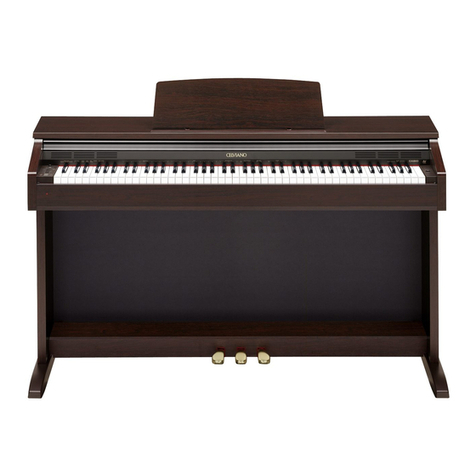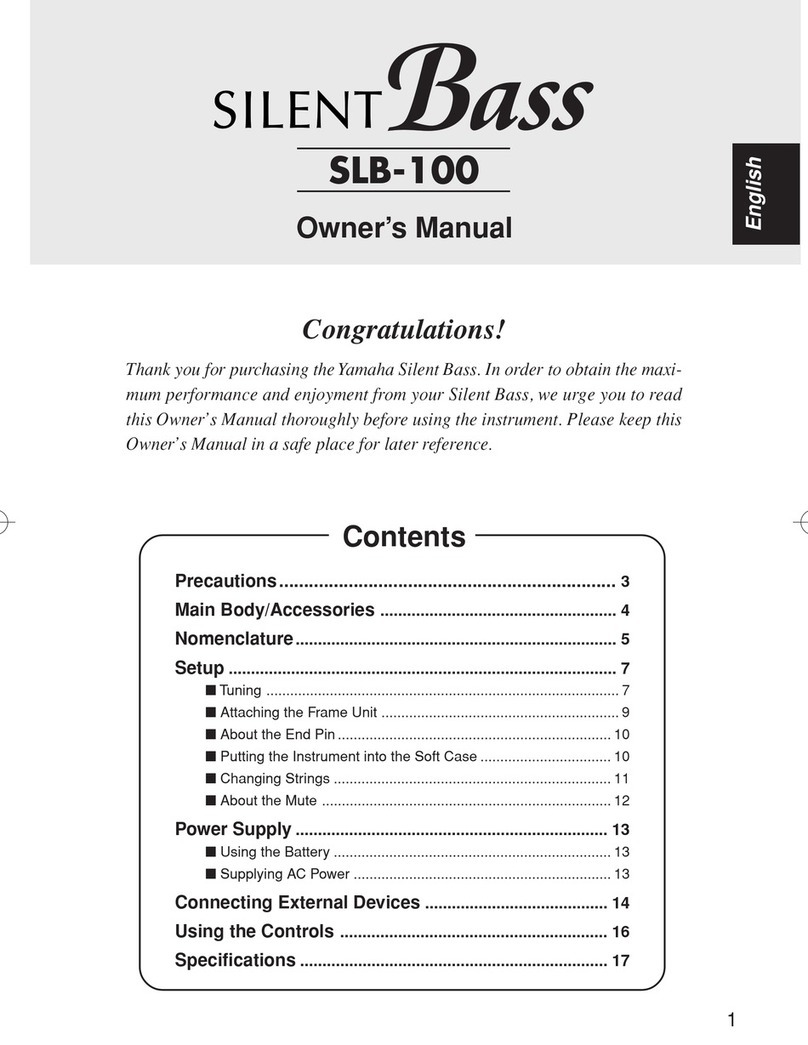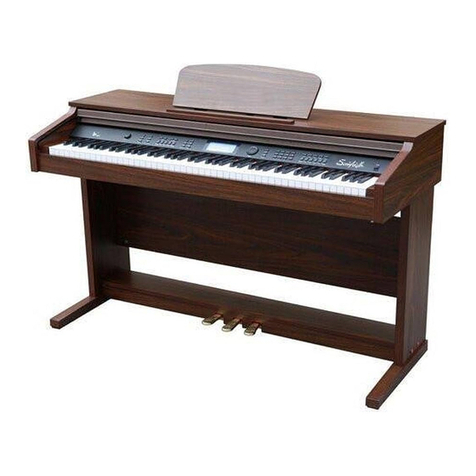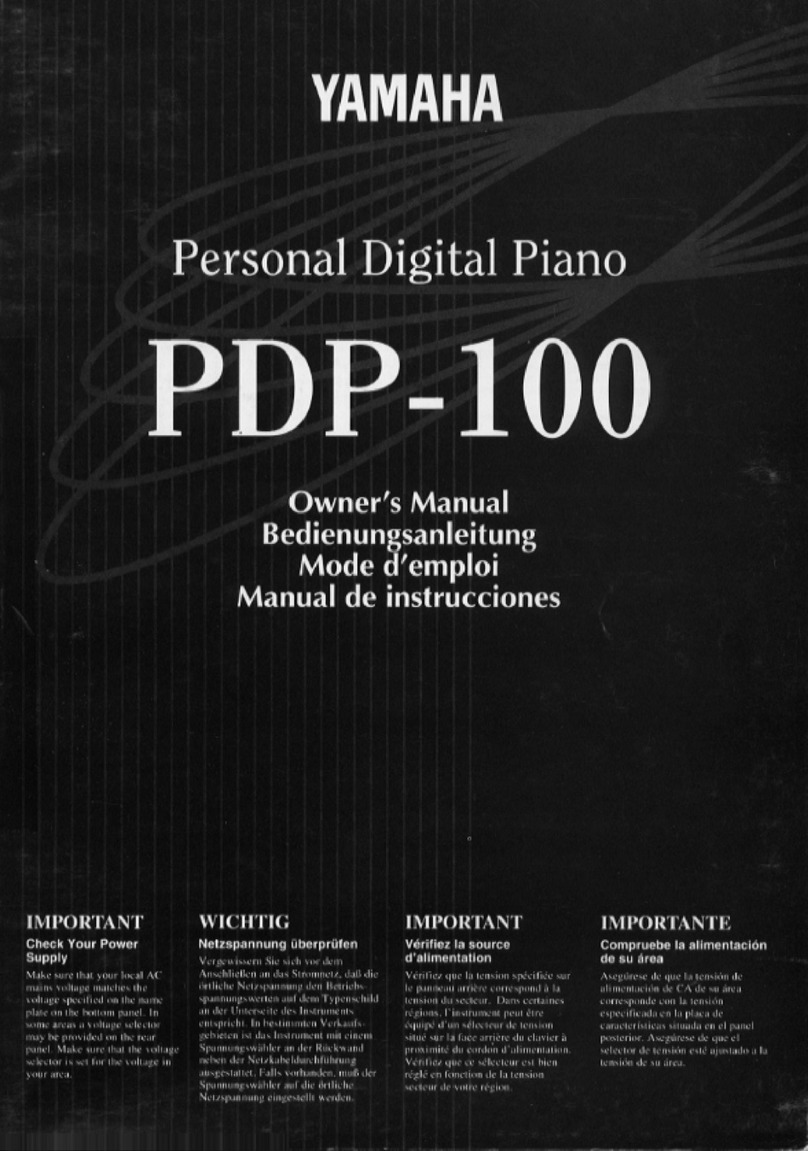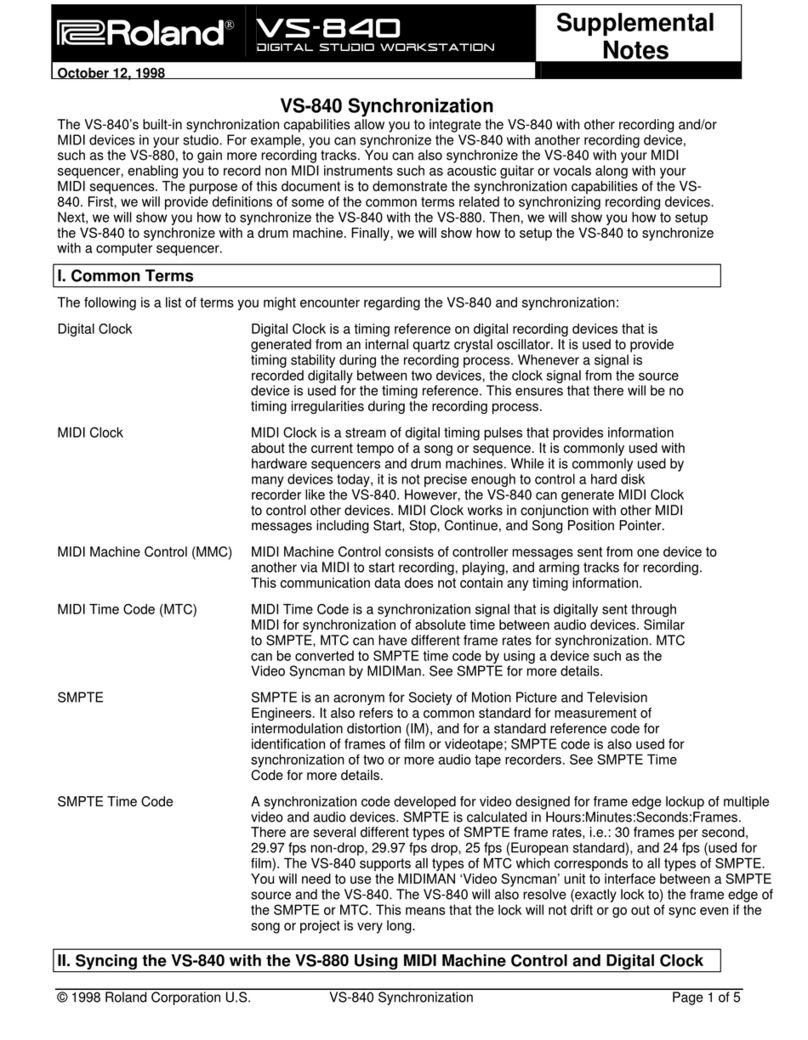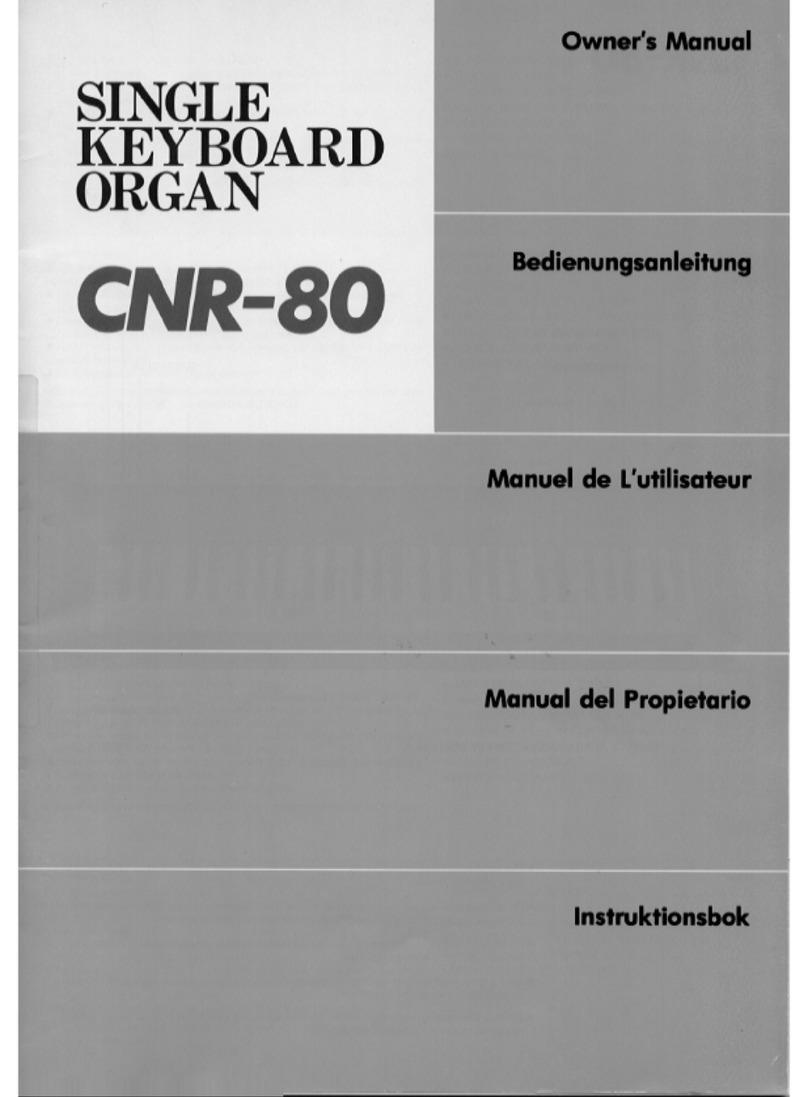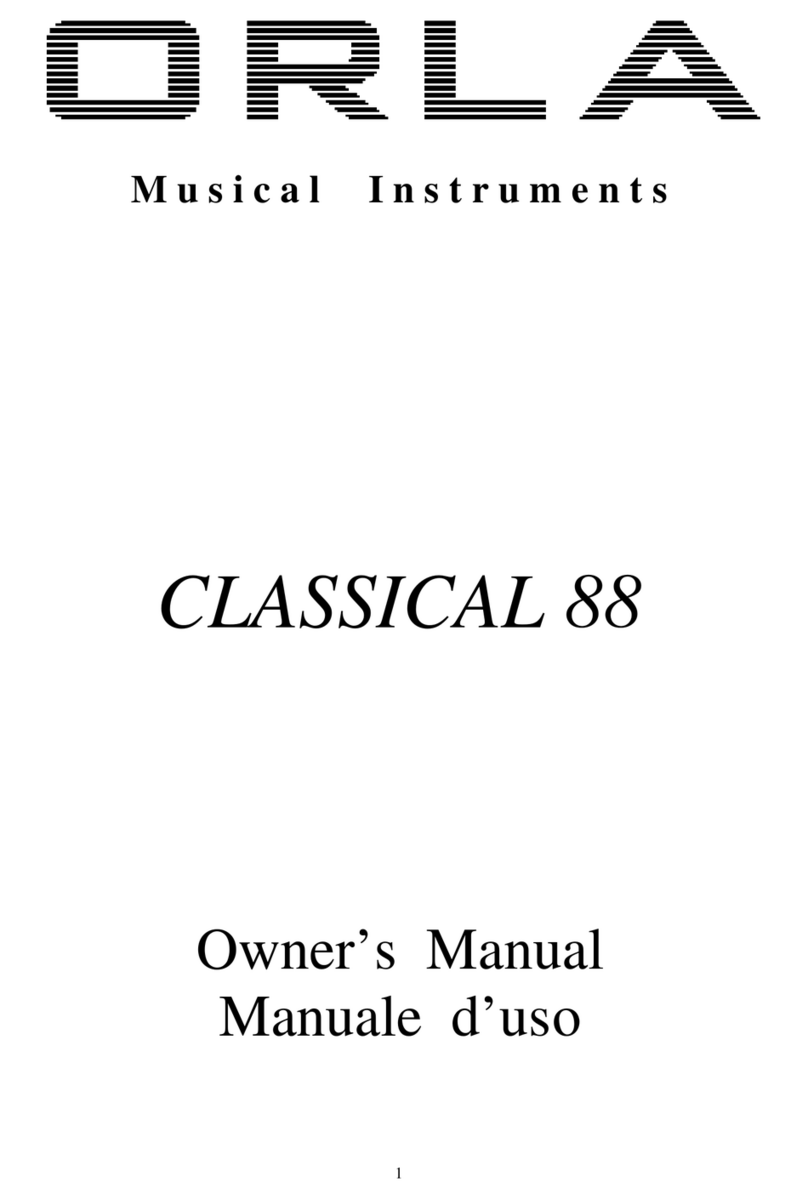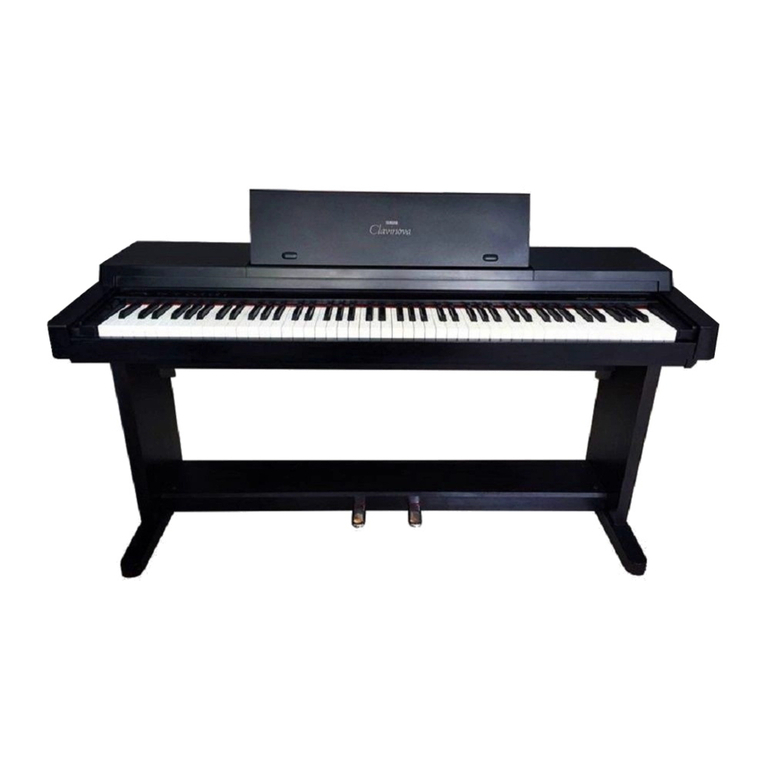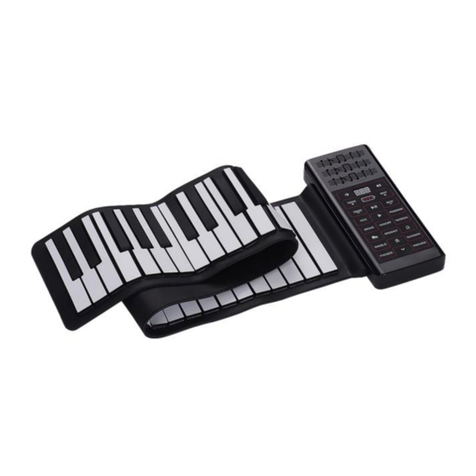MEINL MYO-BCAJ User manual

MAKE YOUR OWN
BONGO CAJON
BONGO CAJON BAUSATZ
BONGO CAJON KIT
BONGO CAJON KIT DE MONTAJE
KIT DI MONTAGGIO BONGO CAJON
KIT DE MONTAGE DU BONGO CAJON
BONGO CAJON KÉSZLET
BONGO CAJON キット
邦哥卡宏套件

Bauanleitung
Bevor Sie mit der Montage beginnen, sollten Sie sich die Bauanleitung gründlich und komplett durchlesen, sowie alle
benötigten Werkzeuge bereitlegen und alle Bauteile sortieren. Weiterhin möchten wir darauf hinweisen, dass eine plane
Arbeitsäche die folgenden Arbeitsschritte wesentlich erleichtern wird.
Korpus verleimen
Beim ersten Arbeitsschritt werden die vier Korpus-Elemente zusammengesteckt und verleimt. Den Leim bitte in die
Nut und auf die äußere Leiste anbringen, siehe Bild 1. Es empehlt sich, diese vier Elemente vor dem Verleimen
kurz zusammenzustecken um eventuelle Verwechslungen zu vermeiden. Um den nötigen Druck für das Verleimen
aufzubauen, werden die 250 mm Schraubzwingen oder die Spannbänder benötigt, siehe Bild 2. Es ist auf die Bün-
digkeit der Elemente und auf den Winkel, wie im Bild 3 zu sehen, zu achten. Überschüssiger Leim kann mit einem
feuchten Tuch entfernt werden. Der Leim sollte mindestens 120 Minuten trocknen, bevor die Pressverspannung
gelöst werden kann.
Korpus verschleifen
Nun werden die Übergänge auf der Ober- und Unterseite des Korpus verschliffen. Hier ist es wichtig die Übergänge
plan zu schleifen, um eine ideale Auageäche für die Schlagäche zu schaffen.
Schlagfläche verleimen
Um ein ideales Verleimen der Schlagäche zu garantieren, empfehlen wir die Bongo Cajon auf die beiden Holzleisten
(ca. 25 x 25 x 300 mm) zu stellen. Diese erleichtern die Verspannung mit den Schraubzwingen oder Spannbändern.
Auf der kompletten Oberseite des Korpus wird nun Leim aufgebracht. Die Schlagäche wird mit Hilfe eines Klebe-
bandes so xiert, dass sie an jeder Seite etwas Überstand zum Korpus hat. Anschließend wird mit Hilfe der Schraub-
zwingen oder Spannbänder die Schlagäche gepresst, wie auf Bild 4 zu sehen ist. Nun nochmals die Positionierung
der Schlagäche prüfen und den Leim für ca. 120 Minuten trocknen lassen.
Soundkammer Trennelement verleimen
Im nächsten Arbeitsschritt wird das Soundkammer Trennelement verleimt. Hierzu wird Leim auf die beiden im Korpus
vertieften Stellen, sowie auf die Kante zur Schlagäche hin, aufgebracht. Hier empehlt sich so viel Leim aufzubringen,
dass das Trennelement luftdicht abgeschlossen ist.
Lieferumfang
1 x Montageanleitung
12 x Seitenelemente, lang
22 x Seitenelemente, kurz
31 x Schlagäche (mit MEINL Logo)
41 x Soundkammer Trennelement
Benötigte Werkzeuge
› Holzleim
› 2 - 4 x Schraubzwingen 250 mm
oder 3 x Spannbänder
› Winkel
› Verschieden gekörntes Schleifpapier
› Schleifklotz
› Klebeband
› 2 x Montagehölzer,
ca. 25 x 25 x 300 mm
1
2
1
3
2
4
Deutsch

Verschleifen
Das Verschleifen der Überstände der Schlagäche ist der nächste Arbeitsschritt. Hierzu empfehlen wir anfangs ein
grobes und dann ein feines Schleifpapier zu verwenden. Mit dem feinen Schleifpapier wird dann auch der komplette
Korpus der Bongo Cajon verschliffen. Für einen besseren Spielkomfort empfehlen wir alle Kanten so zu verschleifen,
dass diese komfortabel abgerundet sind.
Bongo Cajon Finish
Dem Finish der Bongo Cajon sind keine Grenzen gesetzt. Ölen, lackieren, wachsen oder warum nicht auch nach
eigenen Vorstellungen ganz individuell bemalen.
Reklamationen werden nur anerkannt, wenn mit der Montage des Bausatzes noch nicht begonnen wurde. Weiterhin übernimmt die Firma
Roland Meinl Musikinstrumente GmbH & Co. KG keine Haftung für Schäden, welche bei oder durch die Montage entstehen oder entstehen könnten.
Irrtum und Änderungen vorbehalten. Version Mai 2013.
1
5
4
6
3
2

assemBly instructions
Before starting to assemble your bongo cajon, you should carefully read through all the assembly instructions, gather
together all the requisite tools and organise all the components. It should also be noted that a good, level work surface will
make the various steps of the assembly process considerably easier.
Gluing the bongo cajon body
The rst step is to t and glue together the four panels making up the main body. The glue should be applied within
the groove and on the outer batten, see Fig. 1. It is advisable to t these four panels together briey before the ad-
hesive is applied to ensure that they are joined in the right order. To create the necessary pressure for adhesion, the
250 mm screw clamps or the two belt clamps must be used, see Fig. 2. Make sure that the panels t together ush
and at the correct angle, see Fig. 3. Any excess glue can be removed with a damp cloth. The glue must be allowed to
dry for at least 120 minutes before the compressive force is released.
Sanding the body
Next, the surfaces for joining the top and bottom panels of the bongo cajon body should be sanded. It is important
that the joining surfaces should be sanded smooth in order to create a perfect seat for the playing surface.
Gluing the playing surface
The best way of gluing the playing surface is to place the bongo cajon on the two wooden battens (approx. 25 x 25
x 300 mm). These make it easier to apply pressure with the screw clamps or belt clamps. Glue is now applied all
over the top side of the bongo cajon body. The playing surface is secured using adhesive tape with a slight overhang
beyond the bongo cajon body on all four sides. Next, the screw clamps or belt clamps are used to apply pressure to
the playing surface as shown in Fig. 4. The positioning of the playing surface should now be checked again, and then
the glue should be allowed to dry for approx. 120 minutes.
Gluing the sound chamber partition
The next step is to glue the sound chamber partition. This is done by applying glue to the two recesses in the bongo
cajon body as well as to the surface that meets the playing surface. It is advisable to apply sufcient glue to form an
airtight seal around the partition.
Kit comprises
1 x assembly instructions
12 x side panels, long
22 x side panels, short
31 x playing surface
(with MEINL logo)
41 x sound chamber partition
Tools required
› Wood glue
› 2 - 4 x screw clamps 250 mm or
2 x belt clamps
› Square
› Sandpaper, various grades
› Sanding block
› Adhesive tape
› 2 x assembly blocks,
approx. 25 x 25 x 300 mm
1
2
1
3
2
4
English

Sanding
The next step is to sand down the overhangs on the playing surface. For this purpose, we recommend using coarse
sandpaper rst followed by ne sandpaper. The ne sandpaper can then be used to sand the entire body of the
bongo cajon. In order to make the instrument more comfortable to play, we recommend sanding all the edges until
they are nicely rounded.
Bongo cajon finish
When it comes to applying a nish to your bongo cajon, the sky‘s the limit. It can be oiled, lacquered, waxed, or why
not even paint it with an entirely original design?
Warranty claims will only be considered if the assembly process has not been started. Furthermore, Roland Meinl Musikinstrumente GmbH & Co. KG
will not accept liability for any damage incurred or possibly incurred in the course of or as a result of the assembly process. Subject to corrections and
changes. Version dated May 2013.
1
5
4
6
3
2

instrucciones de montaje
Antes de comenzar con el montaje, debería leer atentamente estas instrucciones de montaje completas, preparar todas
las herramientas necesarias y ordenar todas las piezas. Además, recuerde que disponer de una supercie de trabajo llana
facilita notablemente la realización de los siguientes pasos de trabajo.
Encolar el cuerpo
En el primer paso de trabajo se encajan y encolan los cuatro elementos del cuerpo. Aplicar cola en la ranura y en
el listón exterior, véase la figura 1. Es recomendable encajar a modo de prueba estos cuatro elementos antes de
encolarlos con el n de evitar posibles equivocaciones. Para poder generar la presión necesaria para el encolado
se necesitan los sargentos de 250 mm o ambas cintas de apriete, véase la figura 2. Debe tenerse en cuenta que los
elementos deben quedar enrasados y con el ángulo adecuado, véase la figura 3. El exceso de cola puede retirarse
con un paño húmedo. La cola debería secar al menos 120 antes de aliviar la presión de apriete.
Lijar el cuerpo
Ahora se lijan las transiciones de la parte superior e inferior del cuerpo. Es importante lijar las transiciones planas
para conseguir una supercie de apoyo ideal para la supercie de golpeo.
Encolar la superficie de golpeo
Para garantizar un encolado ideal de la supercie de golpeo, recomendamos colocar el Bongo Cajon sobre los dos
listones de madera (aprox. 25 x 25 x 300 mm). Estos facilitan la compresión con los sargentos o las cintas de apriete.
Se aplica cola a toda la parte superior del cuerpo. La supercie de golpeo se ja con ayuda de cinta adhesiva de
manera que sobresalga por todos los lados ligeramente del cuerpo. A continuación, la supercie de golpeo se com-
prime con ayuda de los sargentos o las cintas de apriete como se ve en la figura 4. Comprobar de nuevo el posicio-
namiento de la supercie de golpeo y dejar secar la cola durante aproximadamente 120 minutos.
Encolar el elemento separador de la cámara acústica
En el siguiente paso de trabajo se encola el elemento separador de la cámara acústica. Para ello se aplica cola a los
dos puntos rebajados del cuerpo y a la supercie que entra en contacto con la supercie de golpeo. Es recomen-
dable aplicar una cantidad de cola suciente para que el elemento separador quede obturado contra el paso del aire.
Suministro
1 instrucciones de montaje
12 elementos laterales, largos
22 elementos laterales, cortos
31 supercie de golpeo
( con el logo MEINL)
41 elemento separador de la
cámara acústica
Herramientas necesarias
› Cola blanca
› 2 - 4 sargentos de 250 mm
o 2 cintas de apriete
› Escuadra
› Papel de lija de distintos granos
› Taco de lijar
› Cinta adhesiva
› 2 listones de madera para el montaje,
aprox. 25 x 25 x 300 mm
1
2
1
3
2
4
Español

Lijar
El siguiente paso de trabajo es el lijado de los salientes de la supercie de golpeo. Para ello, recomendamos empe-
zar con un papel de lija de grano grueso y acabar con uno de grano de no. Con el papel de grano no se lija tam-
bién el cuerpo del Bongo Cajon completo. Para mejorar la comodidad a la hora de tocar, recomendamos lijar todos
los cantos de manera que queden redondeados.
Acabar el Bongo Cajon
El acabado del Bongo Cajon no tiene límites. Puede tratarse con aceite, barnizarse, encerarse o, ¿por qué no?,
también pintarse de forma completamente original según los propios gustos.
Solo se aceptan reclamaciones antes de haber comenzado el montaje del juego. Además, la empresa Roland Meinl Musikinstrumente GmbH & Co. KG
no acepta responsabilidad ninguna por daños causados o que pudieran causarse durante ni debido al montaje. Sujeto a errores y modicaciones.
Versión Mayo 2013.
1
5
4
6
3
2

istruzioni di montaggio
Prima di iniziare con il montaggio, si devono leggere accuratamente e completamente le istruzioni di costruzione e montag-
gio, preparare tutti gli utensili necessari ed ordinare tutti i componenti. Inoltre desideriamo richiamare l'attenzione sul fatto
che una supercie di lavoro piana agevola notevolmente le fasi di lavoro.
Incollaggio della cassa
Con la prima fase di lavoro vengono innestati insieme e incollati i quattro elementi che formano la cassa. Applicare la
colla nella scanalatura e sul listello esterno, vedere figura 1. Si consiglia di innestare brevemente insieme questi quattro
elementi prima dell'incollaggio, per evitare eventuali confusioni. Per creare la necessaria pressione di incollaggio, si usa-
no i morsetti a vite da 250 mm o i due nastri di serraggio, vedere figura 2. Occorre prestare attenzione che gli elementi
siano bene a raso e formino un angolo retto, come illustrato nella figura 3. La colla in eccesso può essere rimossa con
un panno umido. La colla deve asciugare per almeno 120 minuti prima di rimuovere gli elementi di serraggio.
Carteggiatura della cassa
Ora vengono carteggiati i punti di passaggio sul lato superiore ed inferiore della cassa. Qui è importante che i punti
di passaggio siano carteggiati in modo livellato, così da creare una supercie di appoggio ideale per la supercie di
percussione.
Incollaggio della superficie di percussione
Per garantire un incollaggio ideale della supercie di percussione, si consiglia di collocare il Bongo Cajón su entrambi
i listelli di legno (circa 25 x 25 x 300 mm). Questi agevolano il bloccaggio con i morsetti a vite o i nastri di serraggio.
A questo punto si applica colla sull'intero lato superiore della cassa. La supercie di percussione viene ssata usan-
do un nastro adesivo, in maniera tale che essa possieda un po' di sporgenza su ogni lato rispetto alla cassa. Succes-
sivamente, con l'aiuto dei morsetti a vite o dei nastri di serraggio viene pressata la supercie di percussione, come
illustrato nella figura 4. A questo punto controllare ancora una volta il posizionamento della supercie di percussione
e lasciare asciugare la colla per circa 120 minuti.
Incollaggio dell’elemento divisore camera acustica
Nella successiva fase di lavoro viene incollato l'elemento divisore della camera acustica. A questo scopo viene
applicata la colla su entrambi i punti incavati nella cassa, e sulla supercie che viene a contatto con la supercie di
percussione. Si consiglia di applicare una quantità di colla sufciente a rendere ermetico l'elemento divisore.
Confezione
1 istruzioni di montaggio
12 elementi laterali, lunghi
22 elementi laterali, corti
31 supercie di percussione
(con logo MEINL)
41 elemento divisore
camera acustica
Utensili necessari
› Colla da legno
› 2 - 4 morsetti a vite 250 mm
o 2 nastri di serraggio
› Squadra
› Carta abrasiva di diversa grana
› Blocchetto abrasivo
› Nastro adesivo
› 2 legni di montaggio,
circa 25 x 25 x 300 mm
1
2
1
3
2
4
Italiano

Carteggiatura
La fase di lavoro successiva è la carteggiatura delle sporgenze della supercie di percussione. A questo scopo si
consiglia di utilizzare inizialmente una carta abrasiva grossolana e poi una ne. Con la carta abrasiva ne carteggia-
re poi anche l'intera cassa del Bongo Cajón. Per un migliore comfort nell'utilizzo dello strumento, si consiglia di
carteggiare tutti i bordi, di modo che risultino arrotondati e non diano fastidio.
Finitura Bongo Cajón
Alla nitura del Bongo Cajón non sono posti limiti. Oli, verniciatura, cera o perché no, anche una pittura
totalmente personalizzata.
Saranno accettati reclami soltanto se non è ancora stato iniziato il montaggio del kit. Inoltre, la ditta Roland Meinl Musikinstrumente GmbH & Co KG non
si assume alcuna responsabilità per danni che si vericano o potrebbero vericarsi durante o a causa del montaggio. Con riserva di errori e modiche.
Versione maggio 2013.
1
5
4
6
3
2

notice de montage
Avant de procéder au montage, il est conseillé de lire attentivement cette notice de montage dans son intégralité, de
préparer tous les outils nécessaires et de trier les différentes pièces. Nous aimerions également souligner que les opérations
suivantes seront beaucoup plus faciles à réaliser sur une surface plane.
Collage du corps
La première étape consiste à assembler et coller les quatre éléments constituant le corps. Appliquer la colle dans la
rainure et sur le bord extérieur, voir photo 1. Il est conseillé de faire un essai d’assemblage de ces quatre éléments
avant de les coller pour éviter toute interversion éventuelle. Pour appliquer la pression nécessaire pour le collage,
utiliser les serre-joints à vis de 250 mm ou les deux sangles de serrage, voir photo 2. Veiller à ce que les bords soient
alignés et que l’angle soit correct, voir photo 3. La colle en excès peut être retirée avec un chiffon humide. Laisser
sécher la colle au moins 120 minutes avant de relâcher la pression.
Ponçage du corps
Les jonctions sur les parties supérieure et inférieure du corps sont ensuite poncées. Il est ici important de poncer les
jonctions an d‘obtenir une surface d‘appui idéale pour la surface de frappe.
Collage de la surface de frappe
An de garantir un collage idéal de la surface de frappe, nous conseillons de poser le bongo cajon sur les deux
barres de bois (approx. 25 x 25 x 300 mm). Celles-ci facilitent le serrage au moyen des serre-joints à vis ou des
sangles de serrage. Appliquer maintenant de la colle sur tout le dessus du corps. La surface de frappe est xée à
l’aide de ruban adhésif : elle doit dépasser légèrement de chaque côté du corps. Mettre ensuite le serrage en place
à l’aide des serre-joints à vis ou des sangles de serrage comme illustré sur la photo 4. Vérier une nouvelle fois le
positionnement de la surface de frappe, puis laisser la colle sécher pendant environ 120 minutes.
Collage de l’élément de séparation caisse sonore
L’étape suivante consiste à coller l’élément de séparation de la caisse sonore. Pour cela, appliquer de la colle aux
deux endroits plus profonds du corps ainsi que sur la surface entrant en contact avec la surface de frappe. Il est
conseillé d’appliquer sufsamment de colle pour que l’élément de séparation soit entouré de façon hermétique.
Matériel livré
1 notice de montage
12 plaques latérales, longues
22 plaques latérales, courtes
31 surface de frappe
(avec logo MEINL)
41 élément de séparation
caisse sonore
Outillage nécessaire
› Colle à bois
› 2 - 4 serre-joints à vis 250 mm
ou 2 sangles de serrage
› Équerre
› Papier abrasif de différents grains
› Cale à poncer
› Ruban adhésif
› 2 barres d’aide au montage en bois,
env. 25 x 25 x 300 mm
1
2
1
3
2
4
Français

Ponçage
L’étape suivante consiste à poncer les parties qui dépassent de la surface de frappe. Nous conseillons pour cela
de commencer avec un papier abrasif grossier, puis de poursuivre avec un papier n. Ce dernier servira également
à poncer ensuite l’ensemble du corps du bongo cajon. Pour un meilleur confort de jeu, nous conseillons de poncer
toutes les arêtes an qu‘elles soient arrondies.
Finition du bongo cajon
Il n’y a aucune limite à la nition du bongo cajon. Il est possible de le huiler, le vernir, le cirer ou pourquoi pas le
peindre selon ses préférences personnelles.
Les réclamations ne seront acceptées que si le montage du kit de montage n’a pas encore commencé. En outre, la société
Roland Meinl Musikinstrumente GmbH & Co. KG décline toute responsabilité pour les dommages survenus ou pouvant survenir lors du montage
ou suite au montage. Sous réserve d’erreur et de modications. Version mai 2013.
1
5
4
6
3
2

INSTRUKCJA MONTAŻU
Przed rozpoczęciem montażu Twojego bongo-cajona, powinieneś zapoznać się dokładnie z całą instrukcją
montażu, skompletować potrzebne narzędzia i akcesoria montażowe. Warto też wiedzieć, że równa,
pozioma powierzchnia, na której będziesz składał instrument, ułatwi Ci zadanie.
Sklejanie korpusu bongo-cajona
Pierwszym krokiem jest dopasowanie i sklejenie czterech paneli, które składają się na korpus bongo-
cajona. Klej powinien być nakładany w bruzdach poszczególnych paneli (rys. 1). Doradzamy, aby
dopasować do siebie wszystkie panele przed rozpoczęciem klejenia, aby upewnić się, że będą
prawidłowo złożone. Aby zapewnić właściwy docisk płyt podczas klejenia, należy użyć docisków
śrubowych lub pasków dociskowych (rys. 2). Upewnij się, że panele są do siebie dopasowane i że jest
między nimi kąt prosty (rys. 3). Nadwyżki kleju można usunąć ściereczką. Klej musi schnąć przez co najm-
niej 2 godziny, zanim dociski zostaną zdjęte.
Wygładzanie korpusu
Teraz wygładź krawędzie korpusu, do których przymocujesz panel do gry. Ważne jest, aby te krawędzie
były gładkie i tworzyły idealną podstawę dla panela do gry.
Przyklejanie panela do gry
Przy wykonywaniu tej czynności, najlepiej będzie umieścić korpus na dwóch drewnianych listewkach
(ok. 25 x 25 x 300mm). Ułatwią one przyłożenie właściwej siły docisku z wykorzystaniem docisków
śrubowych lub pasków. Teraz nałóż klej na całą górną krawędź korpusu bongo-cajona. Przyklej panel i
dociśnij go do korpusu z wykorzystaniem docisków śrubowych lub pasków dociskowych (rys. 4). Teraz
ponownie sprawdź, czy w trakcie wykonywania tych czynności panel do gry nie przesunął się. Jeśli
wszystko jest w porządku, pozwól klejowi schnąć przez ok. 120 minut.
Przyklejanie rozdzielacza komory dźwiękowej
Następny krok to przyklejanie rozdzielacza komory dźwiękowej. Należy nanieść klej na powierzchnię
obu rowków wyżłobionych na wewnętrznej stronie korpusu oraz na krawędź, która będzie się stykać z
krawędzią panelu do gry. Rekomendujemy aby użyć w tym kroku wystarczająco dużo kleju, aby utworzył
on jednolitą spoinę na całej długości klejenia.
Zestaw zawiera:
1 x instrukcja montażu
12 x panel boczny, długi
22 x panel boczny, krótki
3
1 x panel do gry
(z logo MEINL)
41 x rozdzielacz komory dźwiękowej
Potrzebne narzędzia:
› klej do drewna
› 2 – 4 x dociski śrubowe 250mm lub
trzy paski dociskowe
› ekierka
› papier ścierny o różnych
grubościach ziarna
› blok ścierny
› 2 x drewniane listewki
25 x 25 x 300mm (około)
› taśma klejąca
1
2
1
3
2
4
Polski

Wygładzanie korpusu
Następnym krokiem jest wygładzanie wystających krawędzi panela do gry. Do tego celu zalecamy papier
ścierny o grubszych ziarnach. Dopiero w kolejnym kroku wykorzystasz papier drobnoziarnisty. Papieru
drobnoziarnistego możesz też użyć do wygładzenia całej powierzchni bongo-cajona. Aby zwiększyć kom-
fort gry, rekomendujemy wygładzenie wszystkich krawędzi aż do ich zaokrąglenia.
Wykończenie bongo-cajona
Jeśli chodzi o wykończenie bongo-cajona, Twoja wyobraźnia wyznaczy tutaj granice. Możesz go
polakierować, zaolejować, pokryć woskiem, albo namalować na nim co tylko chcesz.
Reklamacje będą rozpatrywane wyłącznie przed rozpoczęciem montażu. Roland Meinl Musikinstrumente GmbH & Co. KG
nie odpowiada za szkody powstałe w trakcie procesu montażu. Niniejsze zapisy mogą być zmienione. Niniejsza wersja
pochodzi z maja 2013.
1
5
4
6
3
2

SZERELÉSI ÚTMUTATÓ
Mielőtt a szereléshez hozzákezdene, olvassa alaposan végig az útmutatót, készítse elő a szereléshez szük-
séges szerszámokat, és csoportosítsa az alkotórészeket. Keressen egy sima, lapos munkafelületet, ami az
alábbi munkafolyamatot jelentősen megkönnyíti.
A test enyvezése
Első lépésként a négy oldalfal összeillesztésére és enyvezésére kerül sor. Az enyvet kenje a horonyba és a
külső szegélyre (1.kép). Tanácsos a négy elemet még az enyvezés előtt összeilleszteni, hogy az esetleges
összecserélést kiküszöböljük. Ahhoz, hogy a megfelelő nyomóhatást elérjük, a 250mm-es csavarszorítóra
vagy a feszítő hevederekre szükségünk lesz (2.kép). Ügyeljen az elemek közötti kapcsolatra és derékszög-
re (3. kép). A felesleges enyvet egy nedves kendővel törölje le. Az enyvnek legalább két óráig száradnia
kell, mielőtt a nyomókötést eltávolítjuk.
A test csiszolása
A test felső és alsó oldalán a találkozásokat összecsiszoljuk, egy szintbe hozzuk, hogy az előlap később
tökéletesen simuljon fel.
Hátfal ragasztása
Ahhoz, hogy az előfal ragasztása biztosan sikerüljön, javasoljuk, hogy a bongo cajont helyezze a fadara-
bokra (kb. 25 x 25 x 300 mm). A két fadarab a csavarszorító vagy feszítő hevederek erejét eloszlatja. A test
oldalainak felső részeit enyvvel bekenjük. Az előfalat egy ragasztószalaggal úgy xáljuk, hogy minden
oldalon a testen valamivel túlnyúljon. Végül a csavarszorítóval vagy feszítő hevederrel a 4. képen látható
módon az előfalat a testtel összeszorítjuk. Ellenőrizze még egyszer a hátfal helyzetét, hagyja az enyvet
kb. 120 percig száradni.
Hangkamrát elválasztó fal beragasztása
A következő lépésben a hangkamrát elválasztó falat beenyvezzük. A testen lévő mindkét mélyedésbe,
valamint az előfalra néző élre enyvet kenünk. Célszerű annyi enyvet felvinni, hogy a választófal légmen-
tesen záródjon.
Alkatrészek
1 x Szerelési útmutató
12 x oldalfal elemek, hosszú
22 x oldalfal elemek, rövid
31 x előlap (Meinl logóval)
41 x hangkamrákat elválasztó fal
Szükséges szerszámok
› faenyv
› 2 - 4 x csavarszorító 250mm vagy
3 x feszítő heveder
› szögmérő
› különböző nomságú
csiszolópapír
› csiszolófa
› ragasztószalag
› 2 x fadarab kb.25x25x300 mm
1
2
1
3
2
4
Magyar

Csiszolás
A következő feladat az előfal tökéletes lecsiszolása. Kezdetben egy durvább, majd később egy nom
csiszolópapírt használjon. A nom pórusú csiszolópapírral végül az egész bongo cajon testét simára
csiszoljuk. A kényelmes játék érdekében javasoljuk, hogy a széleket kissé kerekítve csiszolja le.
Bongo Cajon Finish
A bongo cajon külső megjelenésének kialakításában nincsenek határok. Felületét kezelheti olajjal, lakkal,
viasszal, vagy saját elképzelései szerint be is festheti.
Termékünkkel kapcsolatos reklamációt csak abban az esetben tudunk elfogadni, ha az összeszereléshez még nem fogott
hozzá. Továbbá a Roland Meinl Musikinstrumente GmbH & Co. KG nem vállal felelősséget azokért a károkért, melyek a
szerelés folyamán keletkeztek vagy keletkezhettek. A termékre vonatkozó változtatás jogát fenntartjuk. 2013 május.
1
5
4
6
3
2

組立説明書
組立を始める前にこの組立説明書を最後までしっかりと読み、必要な工具を用意し、すべての組立部分を分類してください。
平らな場所で作業をすることにより、以下の作業がしやすくなります。
本体の接着
最初に本体となる4枚の板を組み立てて接着します。接着剤を図1のように外側の溝に塗ります。板の取り違えを防ぐために、
接着前に一度組み合わせて確認することをお薦めします。確実に接着させるために、クランプ(250 mm)または2本のベルトス
トラップを使用します。(図2参照) 。角に注意して、板の端と端を合わせてください (図3参照)。はみ出た接着剤は、湿らせた布で
拭き取ってください。固定用のクランプ、またはベルトで固定したまま、接着剤を少なくとも120分間は乾燥させてください。
本 体 の や すりが け
本体の正面と裏面のつなぎ目をやすりがけをします。このとき、打面が理想的な面になるよう、つなぎ目が平面になるように
やすりがけすることが大切です。
打面の接着
確実に打面を接着するため、Bongo Cajon を組立用木材(約 25 x 25 x 300 mm) の上に置くことをお薦めします。クランプや
ベルトストラップで容易にクランプすることができます。本体の表面全体に接着剤を塗ります。 打面は両側が本体よりもわず
かにはみ出るように接着テープで固定します。最後に、図4のようにクランプまたはベルトストラップで裏面を固定します。も
う一度打面を確認し、約120分間接着剤を乾燥させます。
サウンドチャンバー・パーテーションの接着
この作業では、サウンドチャンバー・パーテーションを接着します。本体の低くなった部分と打面の取付位置に接着剤を塗り
ます。接着剤は、パーテーションを確実に密着できる量を使用してください。
梱包内容
組立説明書 一部
1側板(長) 2枚
2側板(短) 2枚
3打面板 1枚 (MEINLのロゴつき)
4音響チャンバー パーテーション
必要な工具
› 木材用接着剤
› クランプ 250 mm 4本、またはベルトストラップ 2本
› 角
› 粒度が異なる紙やすり
› 紙 や すりブ ロック
› 接着テープ
› 組立用木材 約25 x 25 x 300 mm
1
2
1
3
2
4
日本語

や すりが け
打面のはみ出した部分をやすりがけをします。やすりがけにはまず、粗い紙やすりを使用してから細かい紙やすりを使用する
ことをお薦めします。細かいやすりを使用して、Bongo Cajon本体全体をやすりがけします。 楽器を演奏しやすいように、すべ
ての角が丸くなるようにやすりがけすることお薦めします。
Bongo Cajon の仕上げ
最終の仕上げで、Bongo Cajon に自由にデザインすることが可能です。オイル、ラック、ワックスなどを使用したり、絵を描いた
りして個性的なBongo Cajon に仕上げてください。
返品・交換はキットの組立前に限り可能です。また、組立作業によって生じた怪我・損害などに関してRoland Meinl Musikinstrumente GmbH & Co. KG は一切責任
を負いかねますのでご注意ください。この説明書の内容は予告なく変更されることがあります。2013年5月版。
1
5
4
6
3
2

安装说明书
在开始安装之前,请认真阅读安装说明书,准备好全部所需工具并对各部件进行分类。
此外,请在平整的工作面上进行安装,以方便实施下述操作步骤。
粘合共鸣箱
第一步:拼插并粘合构成共鸣箱的四块板。向槽中以及外侧棱边上涂抹胶水,参见图 1。建议在涂抹胶水前先将四块板
拼插起来一次,以免发生混淆。为达到所需粘合压力,需使用 250 mm 的活动夹钳或紧固带进行固定(参见图 2)。
操作时,注意确保板的齐平和垂直性(如图 3 所示)。用湿布擦掉多余的胶水。使胶水晾干 120 分钟以上,然后松开
活动夹钳或紧固带。
打磨共鸣箱
现在,对共鸣箱上面及下面的接合处进行打磨。为给敲击板形成理想的支撑面,需将接合处打磨平整,这一点至关重要 。
粘合敲击板
为使敲击板得到理想的粘合效果,建议将邦哥卡宏置于两根安装辅助木条(约 25 x 25 x 300 mm)上。这便于使用活动
夹钳或紧固带进行固定。现在,向共鸣箱的整个正面涂抹胶水。用胶带固定敲击板,使其在每一边上都有超出共鸣箱的
余量。然后,用活动夹钳或紧固带压紧敲击板,如图 4 所示。现在,再次通过检查确保敲击板位置正确,然后使胶水晾
干约 120 分钟
粘合音室隔离元件
接下来,粘合音室隔离元件。向共鸣箱中的两个凹槽中以及敲击板的支撑面上涂抹胶水。建议多涂抹些胶水,确保接合
处的空气被排净。
供货范围
1 安装说明书
12 长侧板
22 短侧板
31 敲击板(印有 MEINL 标志)
41 音室隔离元件
所需工具
› 木材粘合胶水
› 2 - 4 活动夹钳(250 mm)或 2 紧固带
› 角尺
› 粗砂纸及细砂纸
› 磨块
› 胶带
› 2 安装辅助木条,尺寸约为 25 x 25 x 300 mm
1
2
1
3
2
4
中文

打磨
接下来,磨去敲击板上的余量。建议先用粗砂纸粗磨,后用细砂纸精磨。之后,用细砂纸打磨邦哥卡宏的整个箱体。
为使您演奏卡宏时更加舒适,建议打磨全部棱边。
整饰邦哥卡宏
您可以采用各种各样的方式邦哥卡宏进行整饰。您可以在卡宏上涂油、刷漆、打蜡,或是按照自己的想象绘制非常个性化
的图案。
我们仅接受针对尚未开始安装的卡宏套件的索赔要求。此外,对于安装时产生的损失,Roland Meinl Musikinstrumente GmbH & Co. KG 公司不承担责
任。保留修正错误及实施更改的权利。版本:2013年5月
1
5
4
6
3
2

Roland Meinl Musikinstrumente GmbH & Co. KG • Musik-Meinl-Str. 1 • 91468 Gutenstetten • Germany • meinlpercussion.com
Model: MYO-BCAJ
This manual suits for next models
1
Table of contents
Languages:
Other MEINL Musical Instrument manuals

